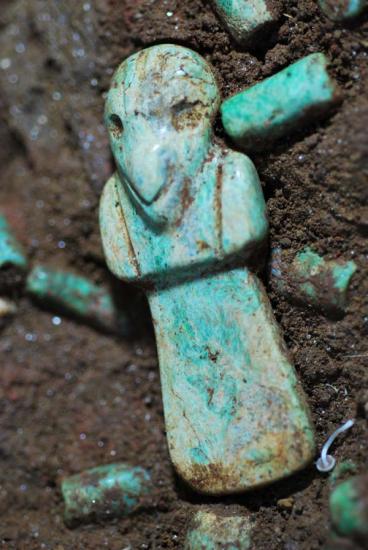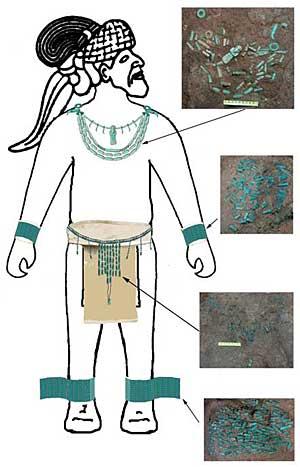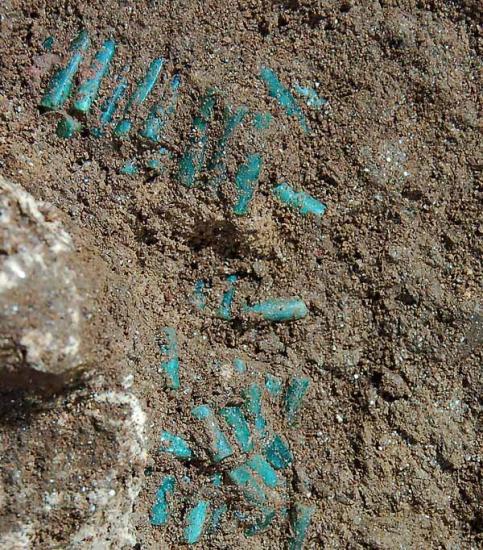Barbara Schieber
Pictures: Courtesy of “Parque Arqueológico Nacional Tak’Alik Ab’Aj , Ministerio de Cultura y Deportes, Dirección General del Patrimonio Cultural y Natural/IDAEH.” National Archeaological Park Tak´Alik Ab´Áj, Ministry of Culture and Soprts, General Directory of Cultural and Natural Patrimony /IDEH.
Source - http://guatemala-times.com/news/guatemala/3379-guatemala-discovering-the-vulture-ancestor-the-oldest-royal-mayan-tomb-in-mesoamerica.html

The discovery of ruler K’utz Chman’s – Royal Vulture Ancestor burial at the dawn of the Maya era at the archeological site Tak’Alik Ab’aj.
The team of the Archaeological National Park Tak’alik Ab’aj –after 10 years of continuous searching- finally was lucky to find the second royal burial, which is particularly interesting, as its pattern differentiates from the first and it is quite more ancient.

Among the findings are unique amazing miniature beads -hundreds of them- of the precious Olmec blue jadeite and apple green (imperial) jadeite, still in position indicating that they were sewn on cloth or leather, embroidered on the bracelets, and anklets, -and even more splendorous- on the loincloth.
The site.
The site lies in the southwest of Guatemala, about 45 km (28 mi) from the border with the Mexican state of Chiapas and 40 km (25 mi) from the Pacific Ocean. Tak´ alik Ab´aj is representative of the first blossoming of Maya culture. Tak'alik Ab'aj' means "standing stone" in the local Kíche´ Maya Language.
The Royal Vulture Ancestor
The calibrated radiocarbon date is 2 SIGMA CALIBRATION: Cal BC 770 to 510 (Cal BP -before present 2720 to 2460, courtesy of Mr. Cernikovsky’s group of 40 friends of archaeology), confirms the date 700 to 400 before Christ based on the stratigraphic and ceramic data. This date corresponds to the 2nd. Part of the Middle Preclassic, Phase Nil, which has been defined as the epoch of transition from the Olmec to the early Maya representation at Tak’alik Ab’aj and situates this burial at the beginning or dawn of the Maya era, and for that reason can be considered the most ancient royal Maya burial with such an sophisticated apparel found in Mesoamerica.

The finding: Burial No. 2 of Tak'alik Ab'aj “K'utz Chman” (Vulture Ancestor/Lord) is situated at the beginning or the dawn of the early Maya era and can be considered the most ancient royal Maya burial with such sophisticated apparel found in Mesoamerica.
The continuation of the excavations following the context of Offering “Las Muñecas” (Dolls) in the central area deep inside Structure 6 at Tak’alik Ab’aj gave place to a discovery which very well can be labeled as the maximum exponent of the archaeological discoveries of the present year 2012 of the 13 Baktun.
This burial is located in a north-south oriented hole dug in the middle preclassic version of Structure 6, immediately south of the Offering the Ancestor Necklace “Collar del Ancestro”, Ancestor Necklace, discovered also last year. The apparel of this second burial, which -as the first one- does not present conserved bones, contains relatively few vessels, but the wonderful six feminine figurines of Offering “Las Muñecas”, and the amazing miniature beads -hundreds of them- of the precious Olmec blue jadeite and apple green (imperial) jadeite, still in position indicating that they were sewn on cloth or leather, embroidered on the bracelets, and anklets, -and even more splendorous- on the loincloth.

This loincloth is unique, with miniature jadeite bead embroidered, loincloth found in situ in Mesoamerica. No other jadeite embroidered loincloth has been found so far.
The necklace, with special forms of beads similar to those found in the Olmec area, has a unique central piece: a so called “standing winged figure” or “celt with bird head”, analogous to the various pieces of the collection at the Museum of Costa Rica, and a piece from the Massive Offering at the site Cerro de Las Mesas, situated at the opposite end in the zone of the Gulf of Mexico, drawing herewith the ancient long distance trade route from the Tehuantepec Isthmus and along the Pacific Coast.

This pendant portraits a human figure with bird head, very likely a vulture, which may represent an early version of the “ajaw” (lord) title, as found at Altar Shook and Stela 1 from the site El Portón, and at Monument 13 from La Venta, which later evolves towards the miniature ceremonial heads of jadeite mosaics.
This burial is of great importance considering the connection with the long distance commercial route passing along the Pacific Coast and the apparent sociocultural development towards regional centers in this geographic region and it provides the opportunity to establish degrees of similitude and/or contrast differences in cultural features and its diffusion.

This finding goes more than 2500 years back -to the beginning or dawn of the Maya era-, and can refer to one of the first Maya rulers at Tak’alik Ab’aj, which as a vanguard did the first step from the representation of the Olmec world towards the innovation of the early Maya world view. As well he could be referred to affectionately as one of the first early Maya with Olmec habits still.
PART.2